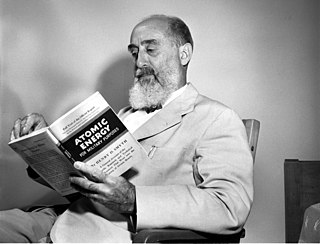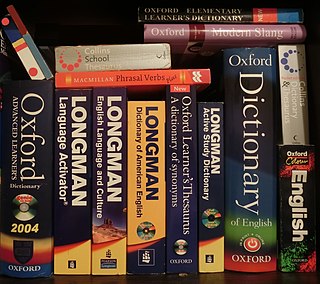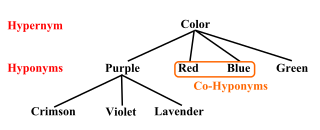
A morpheme is the smallest meaningful unit in a language. A morpheme is not necessarily the same as a word. The main difference between a morpheme and a word is that a morpheme sometimes does not stand alone, but a word, by definition, always stands alone. The linguistics field of study dedicated to morphemes is called morphology.

Natural language processing (NLP) is a subfield of linguistics, computer science, and artificial intelligence concerned with the interactions between computers and human language, in particular how to program computers to process and analyze large amounts of natural language data.
Semantics is the study of meaning. The term can be used to refer to subfields of several distinct disciplines including linguistics, philosophy, and computer science.

A semantic network, or frame network is a knowledge base that represents semantic relations between concepts in a network. This is often used as a form of knowledge representation. It is a directed or undirected graph consisting of vertices, which represent concepts, and edges, which represent semantic relations between concepts, mapping or connecting semantic fields. A semantic network may be instantiated as, for example, a graph database or a concept map.

Whole language is a discredited philosophy of reading, particularly for teaching literacy in English. Its premise is that learning to read English comes naturally to humans, especially young children, in the same way that learning to speak develops naturally. The method became a major model for education in the US, Canada, New Zealand, and Great Britain in the 1980s and 1990s despite there being little scientific support for the method's effectiveness.

An idiom is a phrase or expression that typically presents a figurative, non-literal meaning attached to the phrase; but some phrases become figurative idioms while retaining the literal meaning of the phrase. Categorized as formulaic language, an idiom's figurative meaning is different from the literal meaning. Idioms occur frequently in all languages; in English alone there are an estimated twenty-five thousand idiomatic expressions.

Hyperlexia is a syndrome characterized by a child's precocious ability to read. It was initially identified by Norman E. Silberberg and Margaret C. Silberberg (1967), who defined it as the precocious ability to read words without prior training in learning to read, typically before the age of 5. They indicated that children with hyperlexia have a significantly higher word-decoding ability than their reading comprehension levels. Children with hyperlexia also present with an intense fascination for written material at a very early age.
In computational linguistics, word-sense disambiguation (WSD) is an open problem concerned with identifying which sense of a word is used in a sentence. The solution to this issue impacts other computer-related writing, such as discourse, improving relevance of search engines, anaphora resolution, coherence, and inference.

In linguistics, a hyponym is a word or phrase whose semantic field is included within that of another word, its hyperonym or hypernym. In simpler terms, a hyponym is in a type-of relationship with its hypernym. For example, pigeon, crow, eagle and seagull are all hyponyms of bird ; which, in turn, is a hyponym of animal.
Psycholinguistics or psychology of language is the study of the interrelation between linguistic factors and psychological aspects. The discipline is mainly concerned with the mechanisms by which language is processed and represented in the mind and brain; that is, the psychological and neurobiological factors that enable humans to acquire, use, comprehend, and produce language.
Semantic memory is one of the two types of explicit memory. Semantic memory refers to general world knowledge that we have accumulated throughout our lives. This general knowledge is intertwined in experience and dependent on culture. Semantic memory is distinct from episodic memory, which is our memory of experiences and specific events that occur during our lives, from which we can recreate at any given point. For instance, semantic memory might contain information about what a cat is, whereas episodic memory might contain a specific memory of petting a particular cat. We can learn about new concepts by applying our knowledge learned from things in the past. The counterpart to declarative or explicit memory is nondeclarative memory or implicit memory.
In linguistics, a word of a spoken language can be defined as the smallest sequence of phonemes that can be uttered in isolation with objective or practical meaning. In many languages, words also correspond to sequences of graphemes ("letters") in their standard writing systems that are delimited by spaces wider than the normal inter-letter space, or by other graphical conventions. The concept of "word" is usually distinguished from that of a morpheme, which is the smallest unit of speech which has a meaning, even if it will not stand on its own.
The Levels of Processing model, created by Fergus I. M. Craik and Robert S. Lockhart in 1972, describes memory recall of stimuli as a function of the depth of mental processing. Deeper levels of analysis produce more elaborate, longer-lasting, and stronger memory traces than shallow levels of analysis. Depth of processing falls on a shallow to deep continuum. Shallow processing leads to a fragile memory trace that is susceptible to rapid decay. Conversely, deep processing results in a more durable memory trace.
The N400 is a component of time-locked EEG signals known as event-related potentials (ERP). It is a negative-going deflection that peaks around 400 milliseconds post-stimulus onset, although it can extend from 250-500 ms, and is typically maximal over centro-parietal electrode sites. The N400 is part of the normal brain response to words and other meaningful stimuli, including visual and auditory words, sign language signs, pictures, faces, environmental sounds, and smells.
In linguistics, semantic analysis is the process of relating syntactic structures, from the levels of phrases, clauses, sentences and paragraphs to the level of the writing as a whole, to their language-independent meanings. It also involves removing features specific to particular linguistic and cultural contexts, to the extent that such a project is possible. The elements of idiom and figurative speech, being cultural, are often also converted into relatively invariant meanings in semantic analysis. Semantics, although related to pragmatics, is distinct in that the former deals with word or sentence choice in any given context, while pragmatics considers the unique or particular meaning derived from context or tone. To reiterate in different terms, semantics is about universally coded meaning, and pragmatics, the meaning encoded in words that is then interpreted by an audience.

Lojban is a constructed, syntactically unambiguous human language created by the Logical Language Group. It succeeds the Loglan project.
The early left anterior negativity is an event-related potential in electroencephalography (EEG), or component of brain activity that occurs in response to a certain kind of stimulus. It is characterized by a negative-going wave that peaks around 200 milliseconds or less after the onset of a stimulus, and most often occurs in response to linguistic stimuli that violate word-category or phrase structure rules. As such, it is frequently a topic of study in neurolinguistics experiments, specifically in areas such as sentence processing. While it is frequently used in language research, there is no evidence yet that it is necessarily a language-specific phenomenon.
Priming is a phenomenon whereby exposure to one stimulus influences a response to a subsequent stimulus, without conscious guidance or intention. For example, the word NURSE is recognized more quickly following the word DOCTOR than following the word BREAD. Priming can be perceptual, associative, repetitive, positive, negative, affective, semantic, or conceptual. Research, however, has yet to firmly establish the duration of priming effects, yet their onset can be almost instantaneous.
Semantic primes or semantic primitives are a set of semantic concepts that are innately understood but cannot be expressed in simpler terms. They represent words or phrases that are learned through practice but cannot be defined concretely. For example, although the meaning of "touching" is readily understood, a dictionary might define "touch" as "to make contact" and "contact" as "touching", providing no information if neither of these words is understood. The concept of universal semantic primes was largely introduced by Anna Wierzbicka's book, Semantics: Primes and Universals.

Word recognition, according to Literacy Information and Communication System (LINCS) is "the ability of a reader to recognize written words correctly and virtually effortlessly". It is sometimes referred to as "isolated word recognition" because it involves a reader's ability to recognize words individually from a list without needing similar words for contextual help. LINCS continues to say that "rapid and effortless word recognition is the main component of fluent reading" and explains that these skills can be improved by "practic[ing] with flashcards, lists, and word grids".





